As new social channels emerge and existing platforms update their offerings, the jargon of social media marketing evolves as well.
Today, even people who aren’t so social-savvy know what Facebook is and understand the concept of a “follower” or a “retweet.”
But effective marketers need to know numerous other social media terms, as well as a slew of acronyms, from CPC to ROI.
Let’s take a look at the must-know social media terms that are key to your success as a social media marketer.
1. A/B testing
There are a lot of social media terms under the umbrella of “social testing,” and A/B testing, or split testing, is one of the most basic. It involves changing only one variable of your marketing to see which version — A or B — is most effective.
For example, you may A/B test images in a social ad to see which one performs better. In this case, your two ads would be exactly the same except for the image you use in each one.
2. Algorithm
The set of rules a social media platform uses to rank and organize the content that appears in a user’s feed.
Most social media feeds once displayed posts in chronological order. But today, algorithms prioritize content based on its relevance to the user, among other factors.
Instagram, for example, determines what posts appear in each user’s feed based on the likelihood that the content will appeal to the user, the date the content was published, and the user’s previous interactions with the person who posted the content.
3. Application programming interface (API)
An API is code that makes data or functionality from one site available for use in another application. Essentially, it refers to how various sites or applications can communicate with one another.
In terms of social media terms, API has a host of uses.
For example, it enables social-scheduling tools like Hootsuite and Buffer to make social posts and lets them collect data on how your posts perform.
4. Average response time
This term refers to the amount of time it takes for your organization to respond to a customer on social media.
Facebook even has a feature that displays a business’ average response time.
Why is this important? Because social media provides two-way communication for companies and customers, and today your customers expect a timely response.

In fact, nearly 80% of customers expect a response within 24 hours, and nearly 40% expect a reply within just one hour.
Responding to a customer promptly, answering their questions, and addressing their concerns on social media doesn’t only help that specific customer — it also helps your business because it drives brand loyalty.
Forty-one percent of shoppers view brands that respond to customers more favorably, according to Bazaarvoice. And up to 70% of dissatisfied customers will do business with a brand again if their complaint is resolved.
5. Backlinks
These are links from external sites that point to pages on your own website.
Links from other websites are important because they help establish your domain’s authority, which affects how your site ranks in search results.
In other words, if a lot of high-quality websites link back to your site, it indicates to Google that your domain is authoritative and valuable.
6. Bounce rate
The percentage of visitors who click a link in your post but soon leave the page without viewing other pages or taking any other action.
When it comes to social media, the average bounce rate is about 50%.
Bounce rate is typically higher for social posts than for other channels because users often view the content and then click back to their social feed to continue browsing.
This is especially common when people access social media from mobile devices, which most do. That’s because most links open within the social media app itself and users then return to the main page of the app.
7. Brand advocate
People who are fans of your brand — both inside and outside your organization — who promote it organically via word-of-mouth of marketing.
Brand advocacy increases your brand’s visibility, helps it reach larger audiences, and increases revenue.
The reason it’s so effective is because people trust endorsements from friends, family, and colleagues over those from brands. In fact, 92% of people trust these recommendations over any other type of advertising.
That’s why it’s so important to transform your employees into the organization’s top advocates.
8. Click-through rate (CTR)
The number of users who clicked on a link or ad divided by the number of times an ad, page, or email was viewed (impressions).
This social media term is a ratio commonly used to measure the success of an advertising campaign. A high CTR means that people find your ad to be interesting and relevant.
Let’s say you run an ad campaign that receives three clicks and 100 impressions. That means your CTR is 3%.
Average click-through rate varies by industry, but the average CTR in Google Ads is 1.91% for search and 0.35% for display ads.
9. Conversion rate
The percentage of people who complete a conversion, or a desired goal.
A conversion encompasses a variety of actions, such as filling out a form, making a purchase, or clicking a link to learn more about a product or service.
Conversion rates vary by industry, medium, and social channel, but the average is 2% to 5%. However, many advertisers consider a good conversion rate to be one that’s 10% or higher.
10. Cost per click (CPC)
This refers to the price an advertiser pays for each click their ad receives.
In CPC ad campaigns, the advertiser sets a maximum CPC bid, which is the highest price they’re willing to pay to receive a click.
The average cost per click for Google Ads is $1-$2 for search and less than $1 for display ads.
11. Cross-channel
When you promote something cross-channel, it means it’s being posted across various social networks.
Each network, such as Instagram or LinkedIn, is a channel. So a cross-channel strategy involves a unified approach to your social media strategy across every platform you use.
12. Direct message
A private message sent on a social media platform, such as Instagram, Facebook, or Twitter that’s visible to the sender and the recipient only.
Each social network has its own requirements for sending direct messages or DMs. For example, Twitter users can only send a direct message to people who follow them.
Many brands use DMs to communicate privately with dissatisfied customers that publicly tagged them with a complaint.
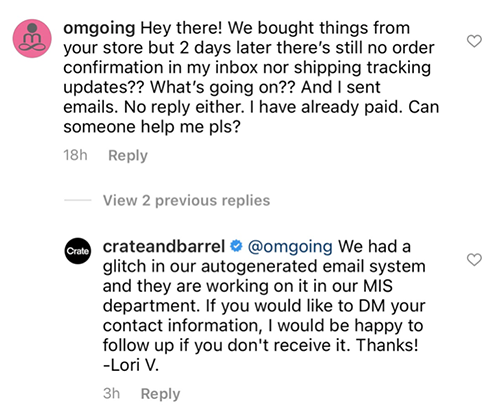
For example, it’s not uncommon for a user to tweet at a brand or comment on a brand’s post about an issue with an order. In these cases, you’ll often see the brand reply publicly, apologize for the inconvenience, and request that the customer DM their order details so they can resolve the dispute privately.
13. Domain authority
A search engine ranking score, from one to 100, that reflects how likely a website is to rank on search engine result pages (SERPs).
SEO and marketing company Moz developed this social media term. It’s often used interchangeably with similar social media terms, such as “domain rating,” which was coined by software company Ahrefs.
A variety of factors influence domain authority, including number of backlinks and linking root domains.

You can check a website’s domain authority for free here.
14. Employee advocacy
The promotion of a company by its employees.
The goal of employee advocacy is to leverage workers’ social networks to benefit both the organization and the employees themselves. In other words, it’s about transforming employees into influencers.
This does much more than simply make your company look good. It also aids marketing, sales, recruitment, employee engagement, internal communications, and more.
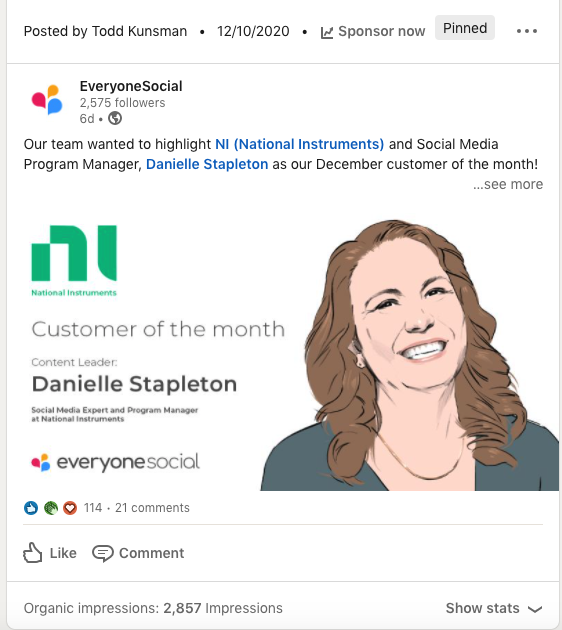
That’s why an employee advocacy platform like EveryoneSocial is essential in the modern workplace.
15. Engagement
A measure of how users interact with your social media content that indicates how the content you share resonates with your audience.
Types of engagement vary depending on the social media platform, but it can include likes, comments, favorites, replies, shares, retweets, clicks, mentions, and saves.
You can calculate your engagement rate for a specific platform by dividing the number of engagements with a post by your number of followers and then multiplying this number by 100.
For example, you’d calculate the engagement rate of an Instagram post like this: Likes + comments + saves ÷ followers x 100.
Average engagement rate varies by industry, but in 2020, the median engagement was 1.16% for Instagram, 0.27% for Facebook, and 0.07% for Twitter.
16. Geotargeting
Adjusting your social ad content to target a specific audience based on location information.
This can include, country, region, state, city, or zip code. It enables advertisers to reach the exact audience that may be interested in their product or service.
17. Hashtag
A keyword or phrase after a # that helps identify topics and organize conversations on social media.
Hashtags make it easy to find posts on a specific topic, such as #marketing, #beauty, #travel, or #EmployeeAdvocacy. And social media marketers can use them to see what’s trending at a given time.
A branded hashtag is one that’s unique to your company that your organization — or social media users who want to tag you or participate in a conversation with your brand — use.
Often, a branded hashtag features the organization’s full or partial name, such as Coca-Cola’s #ShareACoke or Buffy’s #InTheBuff. But there are countless successful branded hashtags that don’t necessarily include the company name, such as REI’s #OptOutside and Spindrift’s #YupThatsIt.
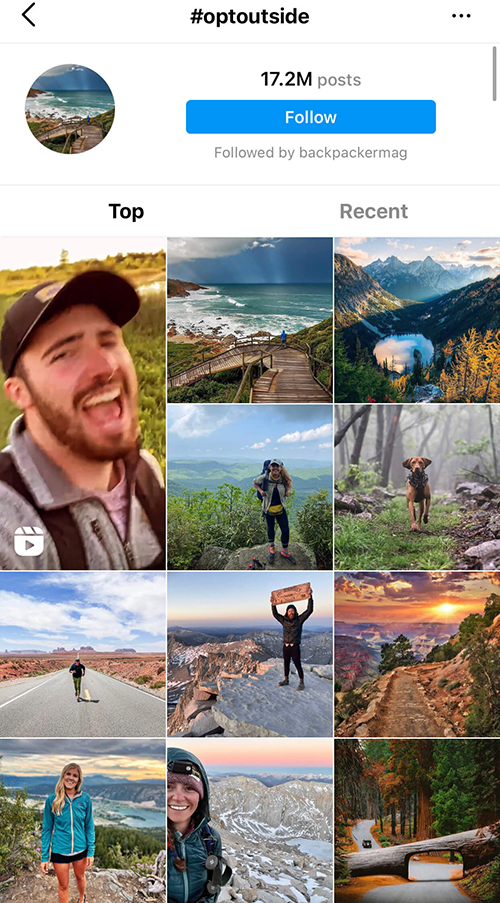
There are a variety of hashtag-tracking tools available to analyze hashtags and help you identify the best ones to use for your industry.
Hashtags are also a phenomenal way for brands to find and gather user-generated content.
18. Impressions
This social media term refers to how many times your post or ad is shown in users’ social feeds.
Impressions differ from reach because reach refers just to the number of people who view your post.
If 1,000 people see your Facebook ad, for example, its reach is 1,000. However, each time the same person is exposed to your ad, its impressions increase. So an ad can receive multiple impressions from a single person if they see your ad more than once.
Each social network calculates impressions in its own way, so keep this in mind when analyzing how your content performs.
19. Influencer
An individual with the power to influence purchasing decisions because of their authority on a subject, position, or reach.
There are six types of social media influencers, and the influencer marketing industry is booming. In fact, it’s expected to reach $13.8 billion in 2021.
20. Key performance indicator (KPI)
A metric used to measure performance over time.
In social media marketing, your KPIs allow you to track social goals and determine if your social media strategy is effective.
A variety of different KPIs can be used to measure performance depending on the goals of your strategy.
For example, if your goal is to increase engagement, you could use likes, comments, or the overall engagement rate as your KPIs. Or, if you want to expand your reach, you might use impressions, follower count, or audience growth rate as your KPIs.
21. Micro-influencer
A social media user who has between 1,000 to 100,000 followers.
There are social media terms for all kinds of influencers, but micro-influencers dominate influencer marketing today for several key reasons:
- They’re authentic. They’re relatable, accessible, trustworthy, and more likely to engage with their audience.
- They have niche followings. They have a specific knowledge with a lot of authority that gives them the power to tap into specific markets.
- They get high engagement. Those with between 10,000 and 50,000 followers have 42% higher engagement than influencers with more than 500,000 followers, according to AspireIQ,
- They have higher conversion rates — more than 20% higher, in fact. Why? Because micro-influencers are such trusted sources.
- They’re more affordable. While a celebrity may charge more than $1 million for a single post, micro-influencers are often willing to team up with a brand for as little as $100 per post.
22. Native advertising
Paid advertising from a third party that looks organic. In other words, the paid content matches the look and feel of the publisher’s regular content even though it’s an ad.
Sponsored Facebook posts and promoted tweets, such as the one below, are types of native advertising. They appear in users’ feeds alongside content from people and brands that the user actually follows.
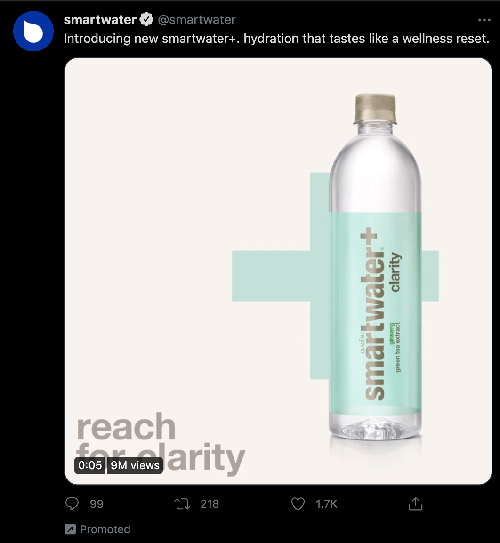
Studies show that consumers look at native ads 53% more often than display ads.
23. Newsjacking
Creating social media content related to current events to garner attention for your brand.
Often, social media managers look to trending topics or hashtags and look for ways to capitalize on an opportunity.
However, as you might imagine, companies that engage in newsjacking sometimes get attention for all the wrong reasons, as this list of newsjacking fails illustrates.
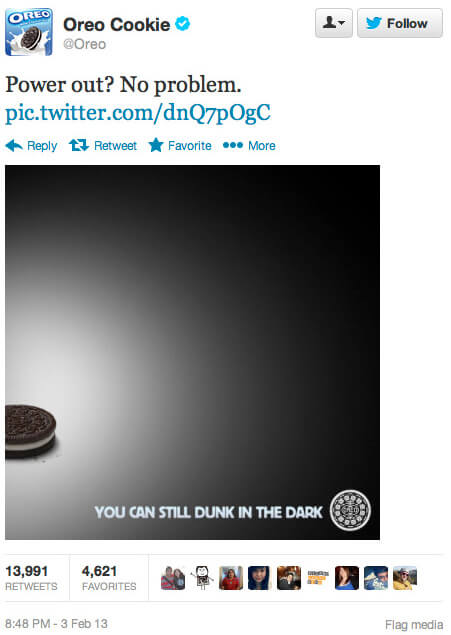
But, when done right — such as in Oreo’s Super Bowl tweet above — newsjacking can be a huge hit for a brand.
24. Pay per click (PPC)
An advertising model where the advertiser pays for each click their ad receives.
This model is typically used to drive traffic to a website.
PPC is often associated with search engines because advertisers bid on keywords relevant to their business and pay when those ads are clicked. The text-based ad below may appear when someone searches Google for “employee advocacy,” for example.
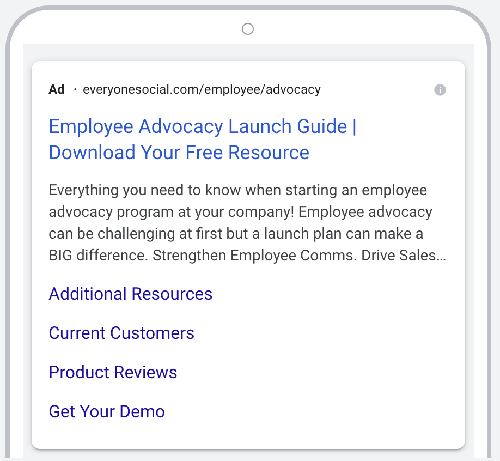
Advertisers can expect to pay $1 to $2 for each click for a Google ad, and the average small-to-medium-sized businesses spend about $9,000 to $10,000 on PPC advertising per month, according to WebFX.
25. Reach
A metric that tells you the number of users who have seen a specific piece of social media content.
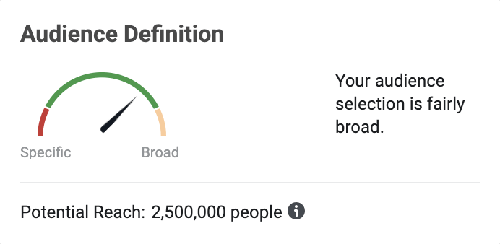
This social media term differs from impressions because it refers only to the number of people who have seen the content.
Your promoted tweet, for example, could have a reach of only 1,000, but it can receive substantially more impressions if the same user views it more than once.
26. Retargeting
An advertising technique in which users are served ads based on their previous online behavior, such as websites they’ve visited before or content they’ve interacted with.
For example, if a user clicks an Instagram ad for a T-shirt but didn’t actually make a purchase, retargeting allows the advertiser to serve the user ads for that shirt or related products during the course of their other browsing activity.
It works by using cookies to remember a person’s previous behavior and displaying user-specific ads to them on websites they visit or social media platforms they use.
27. Return on investment (ROI)
A measure of all what value your social media activity generates.
It’s calculated by dividing the value from your social media actions by how much you spent to achieve them.
Social media ROI can be difficult to estimate for several reasons.
For one, it’s challenging to assign an actual numeric value to a like or retweet, for example. Also, not every social media objective can be easily measured. For example, measuring how your ad contributes to brand awareness isn’t as cut and dry as measuring the number of conversions an ad results in.
28. Sentiment analysis
A subset of social listening that identifies and assesses how social media users feel about your business or product.
In other words, it takes people’s comments, reviews, and other types of feedback on social networks and puts it into context.
There are numerous sentiment-analysis tools on the market today that make it easy to identify how a person feels about a product, service, business, or the company’s content.
These tools allow social media marketers to automatically determine their audience’s mood and feelings about a brand.
29. Social listening
Monitoring your brand’s social media channels for mentions of your brand, its competitors, or key terms or topics related to your business.
Social listening involves looking at such things as comments, hashtags, and mentions to gain insights into what people are saying about your brand, industry trends, and more.
It’s become increasingly important for social media marketers. In fact, in 2020, half of marketers worldwide relied on social listening to tap into consumers’ minds during the pandemic.
Learn how to develop an effective social listening strategy with this comprehensive guide.
30. Social selling
Developing and utilizing relationships during the sales process to help achieve sales goals.
This typically occurs on social media when salespeople share company content, interact with prospects, and answer potential customers’ questions about products and services.
Social selling results in more qualified leads, a better sales pipeline, increased sales, and larger deal sizes.
EveryoneSocial makes social selling a breeze. When Genesys tapped into the power of EveryoneSocial, it increased its sales opportunities by 22% and grew its deal size by 165% in just one year. See how they did it.
31. Trending Topic
A subject, topic, or event that experiences a sudden increase in popularity on a social media platform for a limited period.
Most social platforms track trending topics.
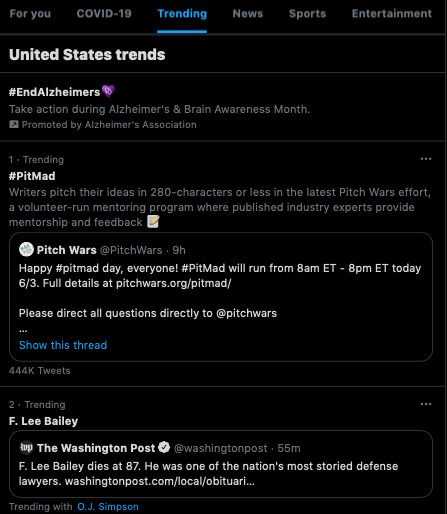
Twitter, for example, provides several categories of trending topics on its platform, including localized and user-specific trends.
32. Trendjacking
When an organization interjects itself into a trending topic by creating branded content around it.
You’ll often see this occur around micro-holidays, such as #NationalDoughnutDay when even brands who don’t have doughnut-related offerings jump on the bandwagon.
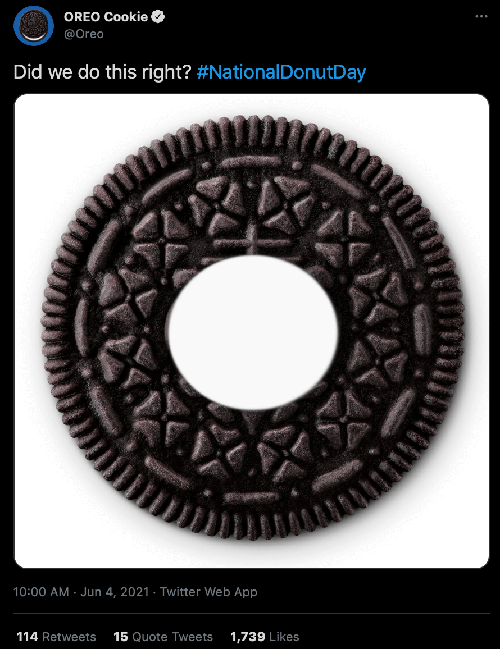
However, brands may participate in trendjacking and insert themselves into a trending conversation at any time, such as Olive Garden did during the finale of a popular television show.

Trendjacking is similar to newsjacking; however, it involves jumping onto a trending topic that’s not specifically news-related.
33. User-generated content (UGC)
Any type of content — images, text, video, and more — posted on social media by unpaid contributors.
This could be an Instagram selfie with a product or a YouTube makeup tutorial featuring a favorite cosmetics line.
UGC is essentially modern-day word-of-mouth marketing, and it’s become an increasingly important component of social media marketing because it’s so effective.
In fact, 85% of people say UGC is more powerful than brand content. Why? Because it’s authentic, engaging, and it converts.
Employee-generated content, or EGC, is content created by employees, and it’s particularly useful for branding, marketing, employee engagement, and recruitment efforts.
34. Vanity metric
There are many social media terms for various metrics, but a vanity metric is unique. It may seem to be an indicator of your social media performance; however, it doesn’t actually give you valuable insights that inform your strategy.
A large number of followers, for example, may certainly look impressive. However, a lot of followers doesn’t necessarily translate into value for your brand.
An account could purchase thousands of followers but their audience may not actually engage with the posted content.
35. Viral
A social media term that describes content that spreads exponentially.
For example, a viral video is one that’s shared rapidly across one or more social media platforms.
Take E.l.f. Cosmetics’ #EyesLipsFace campaign for instance. The viral video spread across TikTok, Instagram, YouTube, and Twitter and is now known as the most viral TikTok campaign ever.
Staying on Top of Social Media Terms is Just the Beginning
Clearly, the lexicon of social media is vast, and it’s undoubtedly important for marketers to master this vocabulary, from A/B testing to vanity metrics.
However, there’s more to success in this dynamic field than simply knowing social media terms — you also need to stay on top of trends.
And the next big thing in social media marketing? Employee advocacy.
“It’s all about turning employees into a powerful force to advocate the company’s brand,” says Mike Edelhart, managing partner of Social Starts.
















